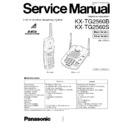Panasonic KX-TG2560B / KX-TG2560S Service Manual ▷ View online
41
KX-TG2560B/KX-TG2560S
8. RX Data Circuit/Hard Mute Circuit
The AF signal output from the RF unit is filtered and amplified by a filter amplifier with a 500 Hz cutoff connected to pins 23
through 24 of IC401. The resulting demodulated data waveform is then input to RX DATA pin 59 of the IC701.
If there is data from the handset during talk operation, the handset data is as shown below to prevent the data from leaking onto
the line. After the data arrives to DSP, muting is applied by the DSP.
Circuit Diagram
59
23
IC701
IC401
R728
C402
13 AF OUT
Data Amp
24
R407
9. ID Code Setting
When the Handset is placed on the base unit, new ID data is output from pin 97 of the DSP after the charge detector operates.
After passing through data amplifier Q312 and the charge terminal, the data is sent to the Handset.
42
KX-TG2560B/KX-TG2560S
10. Calling Line Identification Circuit (Caller ID)
Function:
The caller ID is a chargeable ID which the user of a telephone circuit obtains by entering a contract with the telephone company
to utilize a caller ID service. For this reason, the operation of this circuit assumes that a caller ID service contract has been
entered for the circuit being used.
The data for the caller ID from the telephone exchange is sent during the interval between the first and second rings of the bell
signal. The data from the telephone exchange is a modem signal which is modulated in an FSK (Frequency Shift Keying) format.
Data “0” is a 1200 Hz sine wave, and data 1 is a 2200 Hz sine wave.
There are two type of the message format which can be received: i.e. the single message format and plural message format. The
plural message format allows to transmit the name and data code information in addition to the time and telephone number data.
1st Ring
2 Sec
2 Sec
Silent interval 4 Sec
2nd Ring
2 Sec
2 Sec
0.5 S 575 mS
min 0.5 S
DATA
0.1 Vrms
STD Ring / 20Hz
Tip-Ring
Tip-Ring
DATA in
A
B
DATA out
1200Hz
=DATA "0"
=DATA "0"
1 bit=833
µ
S
2200Hz
=DATA "1"
=DATA "1"
70 Vrms
month
day
hour
minute
number
2013487000
35
16
15
04
Single message format
Plural message format
1st Ring
2 sec
718 ms
2nd Ring
0.5 s
DATA
month
day
hour
minute
number
2013487000
35
16
16
DATA CODE NAME
201
201
John Smith
04
43
KX-TG2560B/KX-TG2560S
•
Call Waiting
Calling Identity Delivery on Call Waiting (CIDCW) is a CLASS service that allows a customer, while off-hook on an existing call, to
receive information about a calling party on a waited call. The transmission of the calling information takes place almost
immediately after the customer is alerted to the new call so he/she can use this information to decide whether to take the new call.
Function:
The CAS signal flows from T/R
→
R106, R107
→
C101, C102
→
IC701 pins 41~43 and the ACK (DTMF signal) is
returned to the telephone exchange. The telephone exchange that received the ACK can send the data in the same manner as
the caller ID. If the unit deems that a telephone connected in parallel is in use, ACK is not returned even if CAS is received, and
the information for the second and subsequent callers is not displayed on the portable handset display.
Call Waiting Format
Circuit Diagram
CAS
CAS: CPE Alerting Signal
Dual Tone of 2130 Hz, 2750 Hz
-15 dBm (900 ohm load)
Dual Tone of 2130 Hz, 2750 Hz
-15 dBm (900 ohm load)
80 5 ms
MARK
DATA
0~500 ms 58~75 ms
about 300 ms
(be changed by
Information Volume)
(be changed by
Information Volume)
Continuance Signal
of 1200 Hz (Data "1")
of 1200 Hz (Data "1")
ACK: Acknowledg Signal
DTMF
"D"
DTMF
"D"
ACK
0~100 ms 60 5 ms
Telephone Exchange
Cordlessphone
Cordlessphone
Signal Flow
Signal Flow
Telephone Exchange
41
42
43
49
IC701
C101
C712
R716
R739
R107
C102
R106
R709
L101
PO101
SA101
1
2
2
T
R
L102
44
KX-TG2560B/KX-TG2560S
11. Parallel Connection Detection Circuit
Function:
In order to disable call waiting and stutter tone functions when using telephones connected in parallel, a circuit that determines
whether a telephone connected in parallel is in use or not is needed. This circuit determines whether the telephone connected in
parallel is on hook or off hook by detecting changes in the T/R voltage.
Circuit Operation:
Parallel connection detection when on hook:
When on hook Q103 is ON, the voltage is monitored pin 40 of IC701. There is no parallel connection if the voltage is 1.65 V or
higher, while a parallel connection is deemed to exist if the voltage is lower.
Parallel connection detection when off hook:
When off hook Q103 is OFF, the voltage is monitored pin 40 of IC701; the presence/absence of a parallel connection is
determined when the voltage changes by 0.2 V or more.
Circuit Diagram
1
2
L101
C103
~
~
D101
C104
R102
R108
RLY
DCIN
USE-CTL
Q103
Q101
Q102
R124
R105
R104
R101
C112
L102
CN101
SA101
99
40
15
P101
R109
R103
IC701
DSP
Click on the first or last page to see other KX-TG2560B / KX-TG2560S service manuals if exist.

